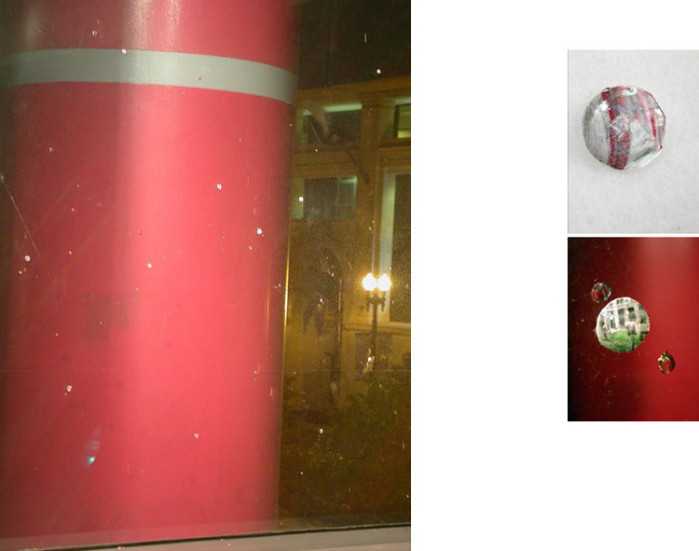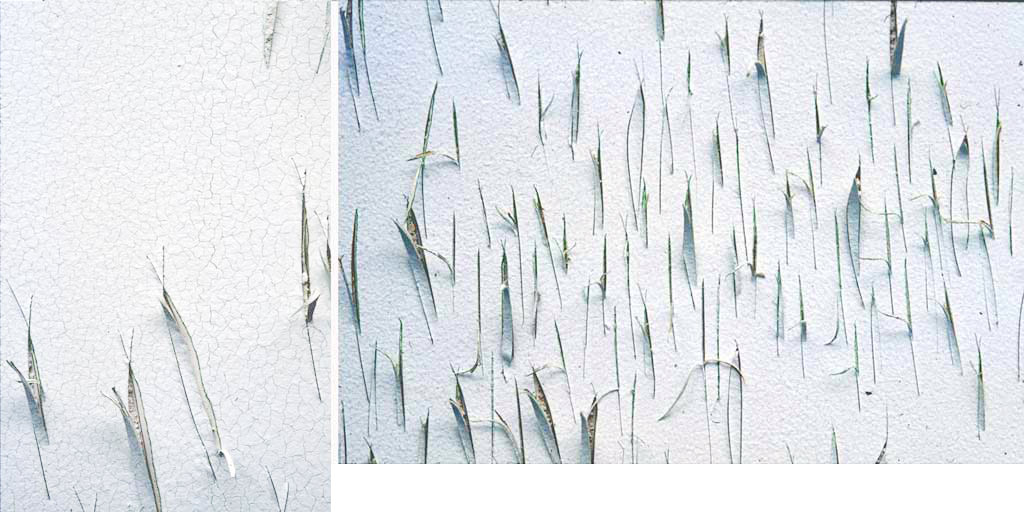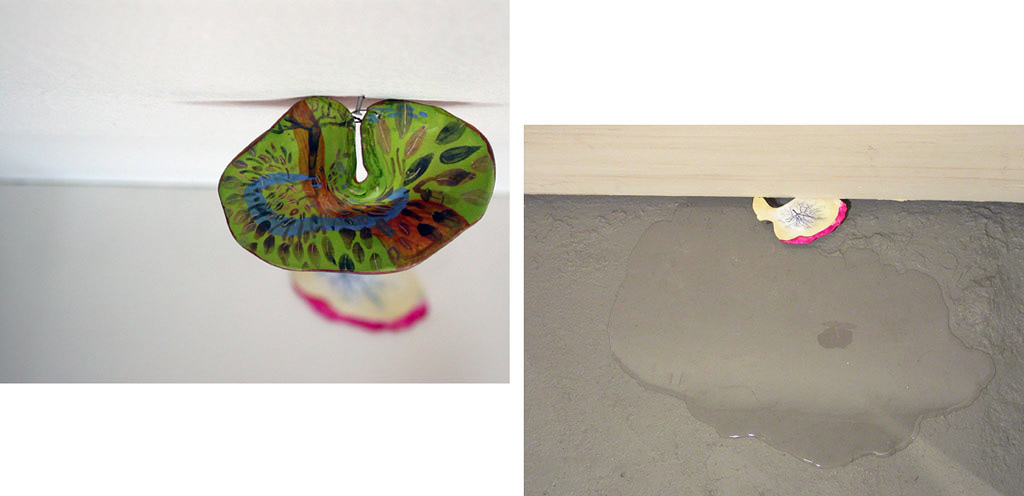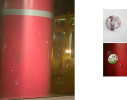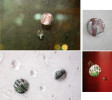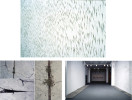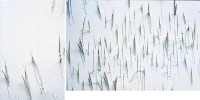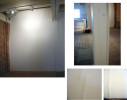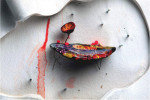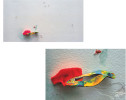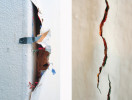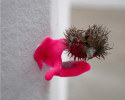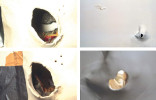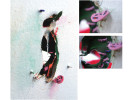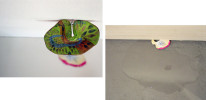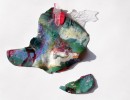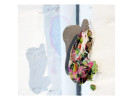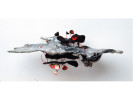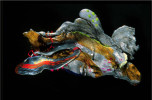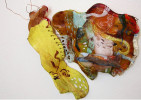Micro-Interventions
Illinois State Museum and other shows
Toward Fracture for Containment, 2004. Illinois State Museum. Hundreds of clear resin droplets (the size of small raindrops) were installed on the large window and sill of the museum, appearing as if it had just rained. Some droplets revealed tiny images of the surrounding environment painted in acrylic and colored pencils.
details- Toward Fracture for Containment, 2004. Illinois State Museum. While transparent droplets changed with the external environment, the painted relfections got strangely stuck, containing and fracturing images of the same environment in bright daylight.
Urban Inscription. 2003. Gallery 2. Painted styrofoam (mimics a sidewalk), Real weeds (growing in the styrofoam sidewalk). The wall (18ft X 14ft) had several coats of paint varying in tonal range from light green at one end to dark green at the other. It was then painted white, cut into and peeled to resemble blades of grass that had white fronts and backs and surprisingly green edges (going from light to dark), when caught at the appropriate angle.
Urban Inscription. 2003. Gallery 2. Wall -details.
Creative Arts Workshop, New Haven. 2004. Solo show – Awarded First Place – National Prize. The show featured several discreet micro-interventions in polymer clay, moss, fungus, petroleum jelly, plaster and fabric dotted over the floor, walls, window, stairs and ceiling. The huge windows were covered in moths and butterflies.
Wallpaper. Lisa Boyle Gallery. 2004. I cast the spaces inside all the cracks, holes and other flaws in the gallery and created a 3 dimensional wallpaper using these to generate pattern.
Plateau. 2003. 1.5inches X 2inches X 2inches. Acrylic on Polymer clay, nails, plaster, wire.
Hollow, 2003. Wood, polymer clay, inserted inseide the wall. 3 inches X 4 inches X 7 inches.
Detail- Negative Skeleton. 2004. The painted copper wire followed all the flaws in the wall almost like a three dimensional shadow,thus amplifying them.
In the Shadow of Pink. 2004. Acrylic on Polymer clay, scratches in the wall.
Details- micro-interventions. Tape, ivy, Polymer clay, nails, Petroleum jelly. Approx: 7inches X 4inches X 4 inches.
Web. 2004. Polymer clay, natural materials, spray painted spider web – suspending the piece.
Detail – micro-intervention. Plaster, mold, mirror, quartz. 8inches X 5 inches.
“Urban Fungus”. Polymer clay, Petroleum jelly, acrylic paint, nails, moss, holes and scratches. 3 inches x 1.5 inches.
Ear and Shadow. 2006. Acrylic on polymer clay. Approx: 3inchesX 2.5inches X 3inches each.
Map. 2006. Acrylic on Polymer clay, plexiglas. 6inches X 5inches X 4inches.
Cliff and Shadow. 2006. Acryic on Polymer clay, with painted and sculpted shadows. Approx: 2inchesX 1.5inches X 4 inches.
“Reflections”. 5inches x7inches x4inches. Acrylic on polymer clay, Aluminum, copper wire.
Tiers. 2004. Piece wrapped around a corner. Acrylic on polymer clay. 2 inches X 1.5inches X 2 inches.
Space age. 2003. Aluminum, copper, acrylic on polymer clay. 5inches X 4 inches X 4 inches.
Hornbill. 2003. Acrylic on polymer clay. 6 inches X 4 inches X 3inches.
Tiny in form, these meticulously constructed pieces magnanimously seem to expand upon closer inspection. These micro-interventions accompanied by miniscule scars and amplified flaws, convert the sterile surfaces into saturated membranes that resist efficiency in viewing, decoding and digesting as it becomes impossible to decide what is the art and what isn’t. Tension is created between the Cultural idea of the gallery space (as a neutral ground) and its Physical Reality as a space with specific qualities. Almost never located at eye level, they often reveal themselves first through peripheral vision. The viewing asks for a de-bracketing of visual attention like infants that are often to close or too far to place a frame on what they “should be” seeing. Objects and materials that have both a contractual realtionship with the space (sculpture/ paintings etc.) as well as intrinsic/ often found (cracks, holes, spider webs etc) realtionship. This enables viewers to often carry this way of looking out of the gallery to regard a weed in the sidewalk or other little fractures in a cultural movement toward control and efficiency. This starts to blur the boundaries between a space set aside for witnessing intellectual cultural activity/ and the outside world.
Micro-Interventions
2012:
TRIAD, Miami, USA
2011:
MAXXI museum, Rome, Italy
MAC museum, Lyon, France
2008:
Galerie Kashya Hildebrand, Zurich, Switzerland
2006:
Van Harrison Gallery, New York, USA
2004:
Museum of Contemporary Art, Chicago, USA
2003:
Gallery 400, Chicago, USA
2003 - 2009:
Illinois State Museum and others, USA

